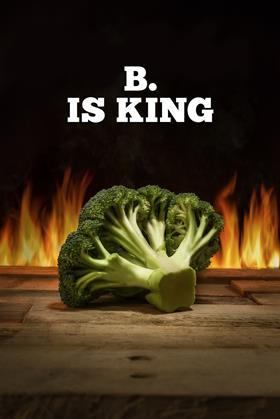
Dramatic, exciting, attention-grabbing: the broccoli commercial produced by political scientist turned chef Samuel Levie has more in common with a Hollywood film trailer than a 5 A DAY-esque consumption campaign.
Using slogans from recognisable brands such as Nike, Kit Kat, and McDonald’s in a build up of messages, a booming voiceover finally incites viewers to “break free, eat broccoli” as the vegetable lands on the screen in slow motion.
Levie’s point is simple: processed food advertising has been phenomenally successful, through using expert advertising companies who know how to tap into the popular culture psyche, whereas fresh produce is far behind the curve in maximising creative marketing talent, despite having a powerful and justifiable message to convey.
“Fast food and processed food advertising is so powerful that companies like McDonald’s don’t even need to use their logo. It made me think, why shouldn’t we come up with campaigns like that for potatoes, carrots and tomatoes?” he explains.
Having previously worked on Obama’s Yes We Can campaign, marketing specialist Levie moved back to the Netherlands and set up his own company, Food Cabinet. “I used methods learnt on Obama’s campaign, along with research into fast-food companies, and applied them to healthy food. It needed to have a clear message, presented in a sexy way so people want to belong to this movement,” he explains, adding that his work is built around the six ‘Cs’: compelling, concise, connected, contrasting, credible and correct.
With an €8,000 budget from the Dutch Produce Association, Levie produced a short video through social media platform Vimeo, which he said gained mass media attention and reached two million people in two weeks. However, this initial campaign didn’t translate into more broccoli sales, as Levie says consumers had no brand or logo recognition when they went to a retailer. Undeterred, he began again – this time tackling declining potato sales in the Netherlands in a multimedia campaign to give ‘Power to the Potato’.
This time the video parodies the rise of the bearded, plaid-shirted ‘hipster’ craze along with its love of ‘superfoods’, positioning the potato as the antidote to modern fads and a true ‘super food’ throughout history. To translate awareness into sales, the video finishes with the campaign logo, which was also found on potato packs in Dutch retailers. The campaign was a success, and Levie now has a two-year contract to work with the Dutch Produce Association on a national consumption campaign. There are clear links between increased intake of fresh produce and greater industry profitability, but marketing isn’t just a case of generating supplementary revenue. Philippe Binard, of European trade body Freshfel, explains: “If we don’t do it, then we have other competing sectors who know how to use the nice, clean image of fruit and vegetables for their own benefit, such as smoothie brands.”
The creativity in Levie’s campaign is what sets his work apart, but the message behind it is also resonant. “Fruit and vegetables have all the components of a good advertising campaign. It’s very easy to be credible, because we don’t need to tell lies,” he says.
Instead, he says fresh produce marketers could portray processed food companies as “the bad guys”, a view echoed by Kelly Brownell, head of public policy at Duke University in the US. “One potential message is that processed food is evil, like tobacco, it manipulates your brain, so eating fresh is a way to avoid this. Corporate manipulation could be a powerful message,” he says. Brownell also believes cross-sector partnerships could provide funding, or lobbying power. “If fruit and veg are ever to compete with dairy, beef and other large sectors it’s going to be important to co-ordinate rather than splinter,” he says. “It can be a very powerful partnership between people who care about public health but from different points of view.”
Creative formats, strong messages and unusual partnerships could prompt a revolution in campaigns to increase consumption of fruit and vegetables. Fresh produce marketers have a wealth of opportunities at their fingertips; it remains to be seen if they will use them.



